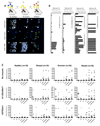A high-throughput O-glycopeptide discovery platform for seromic profiling
- PMID: 20726594
- PMCID: PMC3001163
- DOI: 10.1021/pr1005229
A high-throughput O-glycopeptide discovery platform for seromic profiling
Erratum in
- J Proteome Res. 2011 Mar 4;10(3):1436
Abstract
Biomarker microarrays are becoming valuable tools for serological screening of disease-associated autoantibodies. Post-translational modifications (PTMs) such as glycosylation extend the range of protein function, and a variety of glycosylated proteins are known to be altered in disease progression. Here, we have developed a synthetic screening microarray platform for facile display of O-glycosylated peptides (O-PTMs). By introduction of a capping step during chemical solid-phase glycopeptide synthesis, selective enrichment of N-terminal glycopeptide end products was achieved on an amine-reactive hydrogel-coated microarray glass surface, allowing high-throughput display of large numbers of glycopeptides. Utilizing a repertoire of recombinant glycosyltransferases enabled further diversification of the array libraries in situ and display of a new level of potential biomarker candidates for serological screening. As proof-of-concept, we have demonstrated that MUC1 glycopeptides could be assembled and used to detect autoantibodies in vaccine-induced disease-free breast cancer patients and in patients with confirmed disease at time of diagnosis.
Figures





References
-
- Krueger KE, Srivastava S. Posttranslational protein modifications: current implications for cancer detection, prevention, and therapeutics. Mol Cell Proteomics. 2006;5(10):1799–1810. - PubMed
-
- Robinson WH, DiGennaro C, Hueber W, Haab BB, Kamachi M, Dean EJ, Fournel S, Fong D, Genovese MC, de Vegvar HE, Skriner K, Hirschberg DL, Morris RI, Muller S, Pruijn GJ, van Venrooij WJ, Smolen JS, Brown PO, Steinman L, Utz PJ. Autoantigen microarrays for multiplex characterization of autoantibody responses. Nat Med. 2002;8(3):295–301. - PubMed
-
- Desmetz C, Cortijo C, Mange A, Solassol J. Humoral response to cancer as a tool for biomarker discovery. J Proteomics. 2009;72(6):982–988. - PubMed
Publication types
MeSH terms
Substances
Grants and funding
LinkOut - more resources
Full Text Sources
Other Literature Sources
Molecular Biology Databases
Research Materials
Miscellaneous

